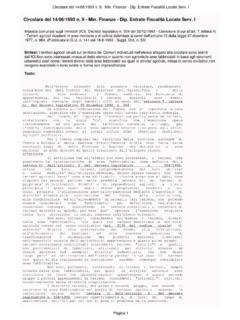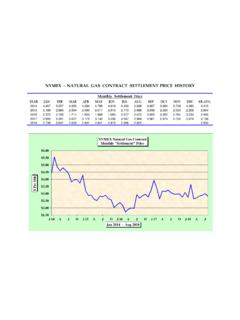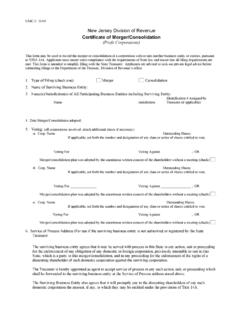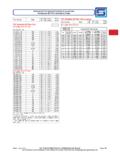Transcription of 3 PHASE AC MOTOR STARTING METHODS - …
1 3 PHASE AC MOTOR STARTING METHODS : A Detailed Analysis of Various METHODS of STARTING an AC Induction MOTOR and Their Effects on MOTOR Characteristics. Thomas Blair, , Phasetronics/Motortronics, Clearwater, Florida This paper will explain basic AC induction MOTOR theory and then apply this theory to describe MOTOR characteristics during STARTING . Then this paper discusses the effects soft STARTING an AC MOTOR has on these various characteristics. Lastly, this paper briefly reviews various METHODS of soft STARTING an AC MOTOR and discusses some of the advantages and disadvantages of each of these METHODS . II. AC MOTOR CIRCUIT THEORY: The standard 3 PHASE AC induction MOTOR has two main components called the rotor and stator. The stator is constructed of a laminated steel core with an interwoven winding.
2 The stator winding is brought out from the MOTOR usually to a terminal or junction box mounted to the MOTOR stator for electrical connection to the MOTOR . The rotor is a laminated core mounted inside the stator housing and is coupled to the shaft of the MOTOR . The stator winding circuit is designed in groups of poles. Each PHASE of a pole group is electrically separated by 120 degrees. If a voltage is applied to the stator winding at some given frequency, then a field is generated internal of the stator that causes the rotor to want to run at a rotational speed defined by the equation below: For a 60 Hz system, the synchronous speed of various quantities of MOTOR poles is shown below. TABLE #1: Synchronous Speeds of 60Hz Motors. For a 50 Hz system, the synchronous speed of various quantities of MOTOR poles is shown below.
3 TABLE #2: Synchronous Speeds of 50Hz Motors. The above listed values are values of synchronous speeds. This is when the rotor is in synchronous speed with the rotating field inside the stator. However, the way a standard AC MOTOR develops torque is by allowing the rotor to lag behind the rotating field inside the stator. This is called slip. The value of slip is defined as the ratio of the difference between rotor synchronous speed and rotor actual speed as compared to the rotor synchronous speed. Mathematically, this is defined as: SlipSynchronous_RPMFull_Load_RPMS ynchronous_RPM The table below defines various amounts of rated slip for various pole count machines and their respective rated (or full load) speeds. 60Hz Motors % Slip 2 Pole 4 Pole 6 Pole 8 Pole 10 Pole 12 Pole 14 Pole 16 Pole 18 Pole 20 Pole 0 3600 1800 1200 900 720 600 514 450 400 360 1 3564 1782 1188 891 713 594 509 446 396 356 2 3528 1764 1176 882 706 588 504 441 392 353 3 3492 1746 1164 873 698 582 499 437 388 349 4 3456 1728 1152 864 691 576 494 432 384 346 5 3420 1710 1140 855 684 570 489 428 380 342 6 3384 1692 1128 846 677 564 483 423 376 338 7 3348 1674 1116 837 670 558 478 419 372 335 8 3312 1656 1104 828 662 552 473 414 368 331 9 3276 1638 1092 819 655 546 468 410 364 328 10 3240 1620 1080 810 648 540 463 405 360 324 11 3204 1602 1068 801 641 534 458 401 356 320 12 3168 1584 1056 792 634 528 453 396 352 317 13 3132 1566 1044 783 626 522 447 392 348 313 14 3096 1548 1032 774
4 619 516 442 387 344 310 15 3060 1530 1020 765 612 510 437 383 340 306 16 3024 1512 1008 756 605 504 432 378 336 302 17 2988 1494 996 747 598 498 427 374 332 299 18 2952 1476 984 738 590 492 422 369 328 295 19 2916 1458 972 729 583 486 417 365 324 292 20 2880 1440 960 720 576 480 411 360 320 288 21 2844 1422 948 711 569 474 406 356 316 284 22 2808 1404 936 702 562 468 401 351 312 281 23 2772 1386 924 693 554 462 396 347 308 277 24 2736 1368 912 684 547 456 391 342 304 274 25 2700 1350 900 675 540 450 386 338 300 270 TABLE #3: Rated Slip Speeds of 60Hz Motors. 50Hz Motors % Slip 2 Pole 4 Pole 6 Pole 8 Pole 10 Pole 12 Pole 14 Pole 16 Pole 18 Pole 20 Pole 0 3000 1800 1200 900 720 600 514 450 400 360 1 2970 1485 990 743 594 495 424 371 330 297 2 2940 1470 980 735 588 490 420 368 327 294 3 2910 1455 970 728 582 485 416 364 323 291 4 2880 1440 960 720 576 480 411 360 320 288 5 2850 1425 950 713 570 475 407 356 317 285 6 2820 1410 940 705 564 470 403 353 313 282 7 2790 1395 930 698 558 465 399 349 310 279 8 2760 1380 920 690 552 460 394 345 307 276 9 2730 1365 910 683 546 455 390 341 303 273 10 2700 1350 900 675 540 450 386 338 300 270 11 2670 1335 890 668 534 445 381 334 297 267 12 2640 1320 880 660 528 440 377 330 293 264 13 2610 1305 870 653 522 435 373 326 290 261 14 2580 1290 860 645 516
5 430 369 323 287 258 15 2550 1275 850 638 510 425 364 319 283 255 16 2520 1260 840 630 504 420 360 315 280 252 17 2490 1245 830 623 498 415 356 311 277 249 18 2460 1230 820 615 492 410 351 308 273 246 19 2430 1215 810 608 486 405 347 304 270 243 20 2400 1200 800 600 480 400 343 300 267 240 21 2370 1185 790 593 474 395 339 296 263 237 22 2340 1170 780 585 468 390 334 293 260 234 23 2310 1155 770 578 462 385 330 289 257 231 24 2280 1140 760 570 456 380 326 285 253 228 25 2250 1125 750 563 450 375 321 281 250 225 TABLE #4: Rated Slip Speeds of 50Hz Motors. The amount of slip required to develop a certain amount of available torque at the MOTOR shaft is very much dependant on the construction of the MOTOR . NEMA (National Electronics Manufacturing Association) has classified motors with respect to their torque vs.
6 Speed characteristics. NEMA B design motors are low STARTING torque motors. That means that the available locked rotor torque value of the MOTOR is less than other types of MOTOR designs. These motors are used on variable torque applications where the STARTING torque requirements are relatively low. These motors are one of the most common types of motors on the market today. NEMA C design motors have a higher STARTING torque value. That means that the available locked rotor torque value of the MOTOR is higher than NEMA B design motors. These motors are used where the load requires a large value of torque to start rotation. NEMA D design motors have large values of rated slip. Where other NEMA designs have rated slip values between 1 to 5%, the NEMA D design rated slip values range between 5 to 15% depending on construction.
7 This means that the MOTOR s rotor slows much more at rated MOTOR torque than other NEMA designs. These motors are used in high peak torque load requirements where system inertia is insufficient to provide the momentary energy to keep a MOTOR at speed. NEMA E design motors are energy efficient motors. One of the more important differences of NEMA E design motors and other motors is the magnitude of the locked rotor current of the MOTOR . Most other NEMA design motors have a value of locked rotor current that is about 6 times MOTOR full load current. NEMA E design motors have a value of locked rotor current that is normally 8 times full load current. The figure below provides an indication of these various NEMA MOTOR designs and their torque characteristics as the MOTOR is accelerated to full speed.
8 FIGURE #1: Graph of Torque Vs. Speed for Various NEMA Design Motors. Where: V = Velocity of the MOTOR rotor in percent of MOTOR synchronous speed. TA = NEMA A design MOTOR available torque. TB = NEMA B design MOTOR available torque. TC = NEMA C design MOTOR available torque. TD = NEMA D design MOTOR available torque. TE = NEMA E design MOTOR available torque. As Figure #1 shows, the MOTOR available torque is dependant on MOTOR rotor speed and MOTOR construction. Actually, MOTOR available torque is dependent on MOTOR stator voltage also as will be discussed when we get to the soft start section of this paper. Now that we understand MOTOR speed or slip and how it affects MOTOR torque, we can define MOTOR power with respect to MOTOR speed.
9 The amount of power available at the shaft of the MOTOR is the product of the MOTOR available torque at the shaft of the MOTOR and the rotational speed of the shaft. This is mathematically defined below as: We can derive the horsepower vs. speed curve by taking the value of torque in the torque vs. speed curve and multiplying it by the speed at each point in the graph to find available power from the MOTOR as the speed of the rotor is varied. This can be seen graphically in Figure 2 below: FIGURE #2: Graph of Horsepower Vs. Speed for Various NEMA Design Where: V = Velocity of the MOTOR rotor in percent of MOTOR synchronous speed. PA = NEMA A design MOTOR available horsepower. PB = NEMA B design MOTOR available horsepower. PC = NEMA C design MOTOR available horsepower.
10 PD = NEMA D design MOTOR available horsepower. PE = NEMA E design MOTOR available horsepower. As Figure #2 shows, the MOTOR available power is dependant on MOTOR rotor speed and MOTOR construction just like MOTOR torque. Actually, MOTOR available power is dependent on MOTOR stator voltage also since it is a function of MOTOR torque and will be discussed when we get to the soft start section of this paper. The next important issue is shaft mechanical stress. The mechanical stress on the shaft of a MOTOR is proportional to the power transmitted through the shaft and is inversely proportional to the rotational speed of the shaft and the cube of the diameter of the shaft. This is described mathematically as: Since we already know that HP is the product of torque and speed, we can rewrite the above equation in terms of shaft torque as shown below: As is shown in the above equation, shaft stress is directly proportional to transmitted torque and inversely proportional to the cube of the diameter of the shaft.






